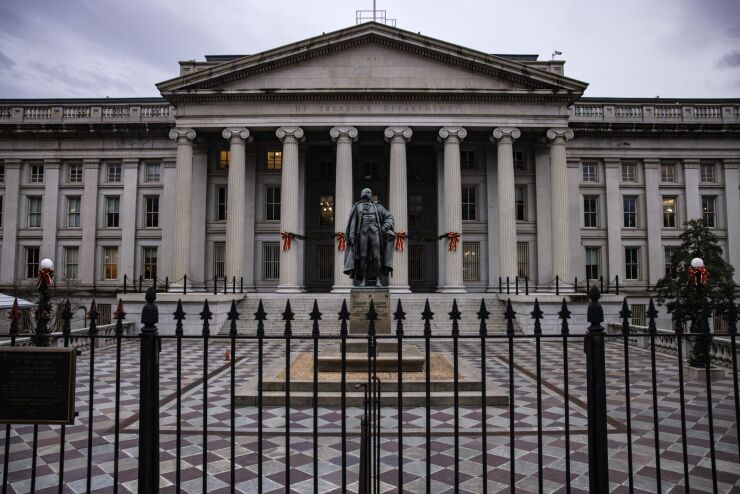(Bloomberg) -- The U.S. Treasury halted dollar debt payments from Russian government accounts at U.S. banks, increasing pressure on Moscow to find alternative funding sources to pay bond investors and avoid a default.
The decision adds another complication to Russia’s attempts to keep meeting debt obligations amid the sanctions imposed after it invaded Ukraine. While the government is so far making payments, some have been delayed by banks doing lengthy checks that they aren’t breaching any restrictions.
The latest measure follows accusations that Russian troops massacred civilians in Bucha and other Ukrainian towns, news that’s shocked the world and pushed governments to consider a tougher response. European countries will discuss the possibility of extending sanctions to Russia’s oil and coal sectors.
The European Union has up to now avoided restrictions that would affect energy flows to the region. But member states are divided on the issue, as payments for oil and gas are helping Russia finance its war. Energy exports are set to hand President Vladimir Putin a $321 billion windfall this year if the commodities continue flowing.
The U.S. announcement is intended to force Russia into either draining its domestic dollar reserves or spending new revenue to make bond payments, or else go into default, according to a spokesperson for the Treasury’s Office of Foreign Assets Control, who discussed details on condition of anonymity.
This “increases the risk of default, not because of lack of money,” said Lutz Roehmeyer, chief investment officer at Berlin-based Capitulum Asset Management. “The new sanction will cause technical issues with regard to the settlement systems, so it is now an open question how Russia will construct the payment routes.”
Debt Watch
Despite warnings from credit-rating companies and others, Putin’s government has so far stayed current on its foreign debt obligations.
A once-$2 billion dollar bond that matured Monday served as the most recent stress test, though Russia was able to buy back about three-quarters of the outstanding amount in rubles before the note came due.
Yet the latest U.S. move will intensify scrutiny on its ability to pay back the remainder of that debt. That payment, plus a coupon on a 2042 bond also due Monday, haven’t yet received Treasury authorization to be processed by correspondent bank JPMorgan, Reuters reported Tuesday.
Coupon payments for the 2042 bond have yet to reach some investor accounts as of Tuesday morning in London, according to bondholders who declined to be named because they are not authorized to speak publicly.
Russia’s dollar bonds, which were already trading well into distressed territory, fell on Tuesday. The 2042 declined 7 points to about 28 cents on the dollar, according to CBBT pricing.
The U.S. action also sharpens the focus on payments due May 27 for interest owed on sovereign dollar and euro notes due in 2026 and 2036. They come two days after previously announced exemptions are set to run out on May 25.
That carve-out has allowed overseas and U.S. investors so far to receive payments on Russian foreign-currency debt, even as the restrictions complicate the process.
‘More Challenging’
Richard Briggs, a money manager at GAM Holdings in London, said the latest move makes sovereign payments “more challenging,” but the exemption means they’re still possible.
“That being said, it’s fast moving, and they could change those restrictions and effectively force a default earlier,” he added.
Russia had foreign-currency and gold reserves of about $604 billion as of March 25. Still, that’s the lowest since August and is down $38.8 billion from a February peak, underscoring the drain since Russia began the invasion.
Russia has been working in recent years to remove the dollar’s hold over its economy and financial markets, which means it’s hacked its holdings of U.S. Treasuries and taken dollar assets from its sovereign wealth fund.
(Updates with EU, comment from analyst, starting in third paragraph)
More stories like this are available on
©2022 Bloomberg L.P.





